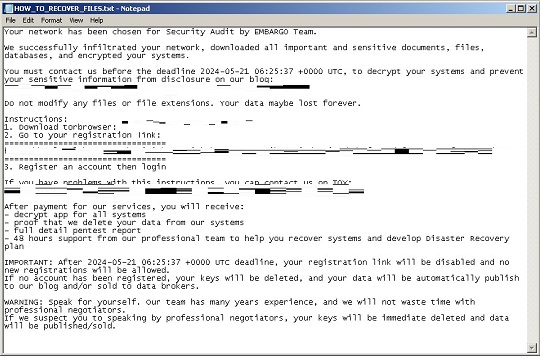Ransom.Win32.EMBARGO.THEAFBD
UDS:Trojan.Win32.Renamer.ch (KASPERSKY)
Windows


Threat Type: Ransomware
Destructiveness: No
Encrypted: No
In the wild: Yes
OVERVIEW
Downloaded from the Internet, Dropped by other malware
This Ransomware arrives on a system as a file dropped by other malware or as a file downloaded unknowingly by users when visiting malicious sites.
It drops files as ransom note.
TECHNICAL DETAILS
6,320,128 bytes
EXE
No
16 May 2024
Disables AV, Terminates processes
Arrival Details
This Ransomware arrives on a system as a file dropped by other malware or as a file downloaded unknowingly by users when visiting malicious sites.
Installation
This Ransomware adds the following processes:
- "%System%\cmd.exe" /q /c bcdedit /set {default} recoveryenabled no
(Note: %System% is the Windows system folder, where it usually is C:\Windows\System32 on all Windows operating system versions.)
It adds the following mutexes to ensure that only one of its copies runs at any one time:
- LoadUpOnGunsBringYourFriends
Process Termination
This Ransomware terminates the following services if found on the affected system:
- GxCIMgr$
- MVArmor$
- VSNAPVSS$
- VeeamNFSSvc$
- QBCFMonitorService$
- GxVssHWProv$
- QBDBMgrN$
- BackupExecRPCService$
- VeeamTransportSvc$
- MVarmor64$
- SAPHostControl$
- SAPHostExec$
- QBCFMonitorService$
- MSExchange\$.*$
- AcronisAgent$
- VeeamTransportSvc$
- BackupExecVSSProvider$
- BackupExecManagementService
- SAPD\$$xecManagementSe
- QBIDPService$
- AcrSch2Svc$
- SAPService$
- SAPHostControl$
- BackupExecJobEngine$ce
- BackupExecRPCService$
- GxClMgrS$
It terminates the following processes if found running in the affected system's memory:
- agntsvc.exe
- dbeng50.exe
- dbsnmp.exe
- encsvc.exe
- excel.exe
- firefox.exe
- infopath.exe
- isqlplussvc.exe
- msaccess.exe
- mspub.exe
- mydesktopqos.exe
- mydesktopservice.exe
- notepad.exe
- ocautoupds.exe
- ocomm.exe
- ocssd.exe
- onenote.exe
- oracle.exe
- outlook.exe
- powerpoint.exe
- sqbcoreservice.exe
- sql.exe
- steam.exe
- synctime.exe
- tbirdconfig.exe
- thebat.exe
- thunderbird.exe
- visio.exe
- winword.exe
- wordpad.exe
- xfssvccon.exe
- *sql*.exe
- bedbh.exe
- vxmon.exe
- benetns.exe
- bengien.exe
- pvlsvr.exe
- beserver.exe
- raw_agent_svc.exe
- vsnapvss.exe
- CagService.exe
- vsnapvss.exe
- QBIDPService.exe
- QBDBMgrN.exe
- QBCFMonitorService.exe
- SAP.exe
- TeamViewer_Service.exe
- TeamViewer.exe
- tv_w32.exe
- tv_x64.exe
- cvd.exe
- cvfwd.exe
- cvods.exe
- saphostexec.exe
- saposcol.exe
- sapstartsrv.exe
- avscc.exe
- DellSystemDetect.exe
- EnterpriseClient.exe
- veeam*.exe
- VeeamNFSSvc.exe
- VeeamTransportSvc.exe
- VeeamDeploymentSvc.exe
Other Details
This Ransomware does the following:
- It attempts to terminate running processes using the Restart Session Manager to encrypt the associated file as such will result to the following registry modification:
- HKEY_CURRENT_USER\Software\Microsoft\RestartManager\Session0000
Owner = {hex values} - HKEY_CURRENT_USER\Software\Microsoft\RestartManager\Session0000
SessionHash = {hex values} - HKEY_CURRENT_USER\Software\Microsoft\RestartManager\Session0000
Sequence = 0x01 - HKEY_CURRENT_USER\Software\Microsoft\RestartManager\Session0000
RegFiles{number} = {file} - HKEY_CURRENT_USER\Software\Microsoft\RestartManager\Session0000
RegFilesHash = {hex values}
- HKEY_CURRENT_USER\Software\Microsoft\RestartManager\Session0000
It accepts the following parameters:
- -t, --threads {THREADS} → number of thread, leave default to automatic assign [default:0]
- -p, --path {PATH} → path to directory, -p R:\backups\ -p \files01\finance -p \10.0.3.2\D$\Accounting
- --no-delete → disable self-delete
- --partial → enable searching for partially encrypted files and finish encrypting (if a previous run failed)
- -l, --log → enable output to log
- -v, --verbose → enable verbose output
- -f, --follow-sym → enable follow symlinks
- -m, --multi-run → allow more than one instance run on the same host
- --no-net → do not search for network resources to encrypt
- -n, --net-path {NETWORK_PATHS} → list of servers to target, -n 10.0.4.2 -n FILES02.contoso.local-n FILES03
- -h, --help → Print help
Ransomware Routine
This Ransomware avoids encrypting files with the following strings in their file name:
- .cpl
- .sys
- .drv
- d3d9caps.dat
- */NTUSER.DAT
- .lnk
- thumbs.db
- .msi
- .search-ms
- .ico
- .dll
- desktop.ini
- .bat
- .lock
- .deskthemepack
- iconcache.db
- .msc
- .theme
- ntldr
- .themeckpack
- autorun.inf
- d3d9caps.dat
- boot.ini
- .spl
- .exe
- .msstyles
- .cab
- .msu
- .themepack
- .564ba1
It avoids encrypting files with the following strings in their file path:
- %ProgramData%/Microsoft/DeviceSync
- %ProgramData%/Microsoft/Diagnosis
- %ProgramData%/ssh
- %Program Files%/Windows Portable Devices
- %Program Files%/Uninstall Information
- %ProgramData%/regid{random}.com\.microsoft
- %ProgramData%/USOPrivate
- %Program Files%/Windows Defender
- %Program Files%/Windows Media Player
- %Program Files%/Windows Security
- %Program Files%/Windows Photo Viewer
- %Program Files%/ModifiableWindowsApps
- %Program Files%/Internet Explorer
- %Program Files%/Windows NT
- %Program Files%/Windows Sidebar
- %Program Files%/WindowsPowerShell
- %Program Files% \(x86\)/Microsoft\.NET
- %Program Files% \(x86\)/Windows Defender
- %Program Files%/Invisible Things Lab/
- %Program Files% \(x86\)/Microsoft/Temp
- %Program Files% \(x86\)/Windows NT
- %Program Files% \(x86\)/Windows Security
- %Program Files% \(x86\)/Windows Mail
- %Program Files% \(x86\)/Windows Sidebar
- %Program Files% \(x86\)/Common Files
- %Program Files%/Common Files/System
- %Program Files%/Windows Mail
- %ProgramData%/ntuser\.pol
- %ProgramData%/USOShared
- %Program Files%/WindowsApps
- %ProgramData%/Microsoft/UEV
- %ProgramData%/Microsoft/Device Stage
- %ProgramData%/Packages/USOShared
- %ProgramData%/Microsoft/Event Viewer
- %ProgramData%/Microsoft/Provisioning
- %ProgramData%/Microsoft/IdentityCRL
- %ProgramData%/Microsoft/NetFramework
- %ProgramData%/Microsoft/Spectrum
- %ProgramData%/Microsoft/Windows Defender
- %ProgramData%/Microsoft/MapData
- %ProgramData%/Microsoft/WDF
- %ProgramData%/Microsoft/Storage Health
- %ProgramData%/Microsoft/Windows
- %ProgramData%/Microsoft/Search
- %ProgramData%/Microsoft/Vault
- %ProgramData%/Microsoft/SmsRouter
- %ProgramData%/Microsoft/Speech_OneCore
- %ProgramData%/Microsoft/Windows NT
- %ProgramData%/Microsoft/MF
- %ProgramData%/Microsoft/Network
- %ProgramData%/Microsoft/WinMSIPC
- %ProgramData%/Microsoft/WPD
- %ProgramData%/Microsoft/EdgeUpdate
- %ProgramData%/Packages/USOPrivate
- %ProgramData%/Microsoft/DRM
- %ProgramData%/USOShared
It appends the following extension to the file name of the encrypted files:
- .564ba1
It drops the following file(s) as ransom note:
- {Encrypted Directory}\HOW_TO_RECOVER_FILES.txt

SOLUTION
9.800
19.344.02
16 May 2024
19.345.00
17 May 2024
Step 1
Trend Micro Predictive Machine Learning detects and blocks malware at the first sign of its existence, before it executes on your system. When enabled, your Trend Micro product detects this malware under the following machine learning name:
-
Troj.Win32.TRX.XXPE50FFF080
Step 2
Before doing any scans, Windows 7, Windows 8, Windows 8.1, and Windows 10 users must disable System Restore to allow full scanning of their computers.
Step 3
Scan your computer with your Trend Micro product to delete files detected as Ransom.Win32.EMBARGO.THEAFBD. If the detected files have already been cleaned, deleted, or quarantined by your Trend Micro product, no further step is required. You may opt to simply delete the quarantined files. Please check the following Trend Micro Support pages for more information:
Step 4
Restore encrypted files from backup.
Did this description help? Tell us how we did.

